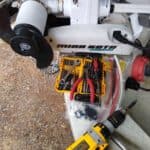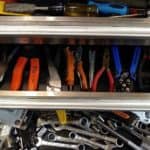My current top choice for a battery is a group 31 12-volt AGM battery of at least 100-amp hours. I have had the best luck with this battery type in my boat. AGM batteries have proven easy to charge and shock-resistant. In the future, if budget permits, I am going to try drop-in lithium batteries, but you have to bring your money for that.
Note: most links in this article are Amazon.com Affiliate links, see Affiliate Disclosure, thank you.
What are the main two categories of batteries?
There are two main categories of batteries, cranking batteries, and deep cycle batteries, this does not include types of batteries, just what the batteries are designed to do. A cranking battery is for starting a vehicle. Usually, these batteries are rated in CA or CCA, respectively cranking amps and cold cranking amps.
This type of battery is usually a flooded lead-acid battery, but we are going to discuss that in a later section. For starting your car cranking batteries are designed for a short burst of high power.
Then you have deep cycle batteries, most are made to be discharged to 50% and then recharged for one complete cycle. Most of these batteries have a rating in amp hours(ah).
This rating is how many total amps a battery can supply over a fixed time in hours, and we are going to use 20 hours for this post because it is an industry standard that most manufacturers use. As a good example, my primary batteries provide just over five amps per hour (101ah = 5.05amps x 20hours).
In the category of deep cycle batteries, there are multiple types of batteries that we are going to discuss in this post. Cycle life is a big issue to me that I have struggled with over time.
As I have learned more about batteries, it has become clear to me that I should not discharge a battery under 50%. A battery’s percentage that you can discharge it to is precise. If you go past that percentage, you can significantly reduce your total charge cycles/battery life.
Sourcing all of this information was difficult, so for this post, I am only using manufacture data on group size 31 if available from Penn-Deka (Eastpennmanufacturing.com, 2019) and Trojan (Trojanbattery.com, 2019) to be consistent and because I currently am using products from both manufacturers.
What are the different types of deep cycle batteries?
Because this is a discussion about trolling motor batteries, we are going to skip regular old-fashioned car batteries designed for starting and focus on deep-cycle batteries. There are deep-cycle batteries available in all types of chemistry, and each has its advantages and disadvantages.
flooded lead-acid
105 ah – trojan group 27
190 min@25
600 cycles @ 50%
60 weight in lbs.
Flooded lead-acid batteries are by far the cheapest batteries available. A flooded lead-acid battery requires regular maintenance. You need to make sure that the battery is contained in a battery box and watch for acid overflows.
Flooded lead-acid batteries require you to constantly check the fluid level and top it off with distilled water. You should always check with the manufacturer or the business that you plan on purchasing a battery to see what the cycle rating is because if you buy a battery that can only cycle 200 times than that determines the life cycle of your battery.
My first ever electric trolling motor battery for my tiny car top aluminum boat was a lead-acid flooded battery that I bought at the sporting goods store. It worked just great for that small motor but would not work to provide the power for what I need on my current setup.
Another thing to consider about these batteries is that most of them are not designed to take heavy shock, like moving your boat at 35 miles per hour in rough water, which can also cause acid to spill. I am currently running two Trojan 1275 batteries of this type because they have an excellent ah rating (150).
My options on where to place the batteries in the boat are extremely limited because of the required maintenance and size. I am not going to be purchasing another set of these batteries. I cannot recommend this battery type to anyone with a boat that would travel above ten mph because of the acid spill issues.
Click here to see a Trojan deep cycle battery on Amazon.com
AGM
100 ah – trojan group 31
210 min@25
1000 cycles @ 50%
68.5 weight in lbs.
AGM (absorbed glass mat), batteries are a battery with glass mats between the plates to hold battery acid and prevent it from flowing freely throughout the battery. Plates are in closer proximity, and the glass mat is between those plates to achieve this result, which allows the battery to discharge and recharge more effectively.
These batteries are known for being extremely durable, which can be great in a boat. AGM batteries have a great life span easily recharging 1000 cycles or more when properly cycled. In my experience, it is easy to pass the 50% level, so error around 60% level or buy new batteries like me.
AGM batteries are maintenance-free with pressure relief valves (VRLA), making them very flexible for mounting in strange positions and tight spaces in boats. Rough water and general vibration are normally not an issue for an AGM battery as they are very shock-resistant and durable well above flooded lead-acid batteries. I always recommend battery boxes, but I have never had an AGM battery leak.
gel cell
97.6 ah – trojan group 31
190 min@25
1000 cycles @ 50%
68.5 weight in lbs.
Gel cell batteries are batteries that have had silica added to immobilize the electrolyte in the battery. Gel cell batteries have a long life and deeper cycles. So, you should be able to run them down past 50% and still recharge them more cycles than flooded or AGM batteries.
The specifications on this vary widely on how many cycles you can get, but some of the tables show up to 5000 cycles at 20% use down to 500 cycles at 80% use. The lower voltage could be bad for your electrical system, by causing heat and damage to electronic equipment.
One of the biggest things to consider is that they are the touchiest batteries for recharging. It is an absolute must that you have a gel battery charger or a smart charger with a gel set. I have heard many people refer to AGM and spiral cells as a gel, and they are not the same.
When I first tried a gel cell battery, I was not impressed, but it was not a gel cell. A salesperson had misinformed me that the round cell battery I was buying was gel cell it was a form of spiral AGM, and I misused the battery resulting in a shortened life for an expensive battery.
Gel batteries are similar to AGM batteries in cost, durability, and mounting options. Keep in mind that if you have an existing system and want to switch to gel batteries, you will most likely need to change out your charge, and also you cannot connect to your motor charging system without a special charge controller.
Lithium
111 ah – trojan group 27 (Trojanbattery.com, 2019)
265 min@25
7000 cycles @ 50%
30 weight in lbs.
Lithium, LiFePO4, or lithium iron phosphate is the latest and greatest technology that promises to be the best, but at a cost. In this section, we are just going to talk about drop-ins. Drop-Ins Lithium batteries are a battery that has the same configuration as a standard 12-volt battery designed to replace your current deep cycle battery with no major changes.
The battery case looks like every other battery you have ever seen, but inside is a whole different animal. There is a bulk of lithium-ion cells to add up to the correct voltage and then a BMS (battery management system) unit to control the operation of those cells.
I researched one manufacturer site, and it stated that the full power charge cycle life would easily be 3,000 cycles at normal operating conditions when 90% of the battery capacity was used. When I did more research, Trojan was stating almost 4000 cycles on 90% use cycles.
If this works out that would easily be more than five times the AGM batteries that I currently use as my secondary power source. The weight of this Trojan battery is less than half of the current battery that I am running and is more compact at group 27 size instead of a group 31.
The price of the LiFePO4 is just over three times as much as I paid for my AGM battery. I did the math, and if the charge cycles are correct the cost of this battery should be half as much in the long term, but it could take ten years to see the formula to completion.
I currently use four batteries in a 2-bank configuration. It might be possible to use only two batteries if you can use 80% of the battery’s capacity, which cuts the cost of your system’s batteries in half. An additional advantage of the lithium battery technology is that you can draw full amperage until the battery is dead.
With other battery technologies, the voltage slowly drops, which causes your amperage to increase, and this is bad for every part of your system, from wiring, electronic components, to the electric motor itself. One final note is that not all BMS units will work wired in series so if you have a 24-volt or 36-volt system you should check on that before your purchase.
My top four batteries for your electric trolling motor
- VMAX MR137-120ah AGM Sealed Marine Battery 12V(best value)
- Odyssey 31M-PC2150ST-M Marine Dual Purpose Battery 12V(dual purpose)
- NPP 120Ah 12Volt AGM Sealed Lead Acid Battery(best buy)
- Mighty Max Battery 12V 55Ah Deep Cycle Battery(lightest weight option)
Click here to read our review of Trolling Motor Batteries
Click here for my article A Beginner’s Guide to the 10 Best Lightweight Trolling Motor Batteries
Conclusion:
As of this post, I, am still recommending the AGM batteries because of their proven performance. The AGM batteries work well with the electric trolling motors. All standard smart battery chargers can easily maintain AGM batteries without damaging them and shortening their life span.
The maintenance of AGM batteries is little, and that is a significant factor for me because I have to make an effort to maintain my flooded lead-acid battery to get the full life out of it. One final note, you should always buy batteries that will be grouped at the same time, of the same type, and the same size.
Click here to check out my article on trolling motor and battery weight.
Resources:
Eastpennmanufacturing.com. (2019). [online] Available at: http://www.eastpennmanufacturing.com/wp-content/uploads/2017-Deka-Spec-Sheet-Final-Rev-4-10-17_FULL.pdf [Accessed 18 May 2019].
Trojanbattery.com. (2019). [online] Available at: https://www.trojanbattery.com/pdf/ProdSpecGuide.pdf [Accessed 18 May 2019].
TrilliumTrojanbattery.com. (2019). [online] Available at: https://www.trojanbattery.com/pdf/datasheets/27_Lithium_12.8-110.pdf [Accessed 18 May 2019].




